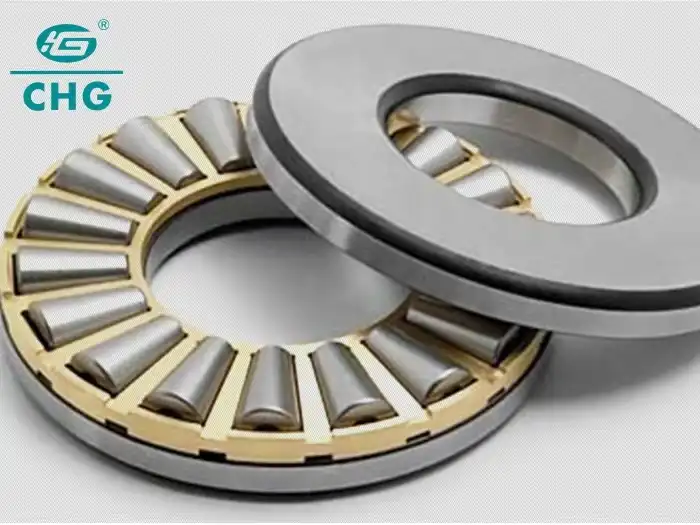Thrust Roller Bearing Load Capacity and Performance Factors
Thrust roller bearings are crucial components in various industrial applications, designed to handle significant axial loads while ensuring smooth rotational movement. These specialized bearings play a vital role in supporting heavy machinery and equipment, particularly in scenarios where large thrust forces are encountered. The load capacity and performance of thrust roller bearings are influenced by numerous factors, including their design, materials, lubrication, and operating conditions. Understanding these factors is essential for engineers and maintenance professionals to optimize bearing selection, maximize operational efficiency, and extend equipment lifespan. This blog post delves into the intricacies of thrust roller bearing load capacity and the key performance factors that determine their effectiveness in various applications, from heavy machinery to precision instruments.
What are the main types of thrust roller bearings and their load capacities?
Cylindrical Roller Thrust Bearings
When you need to handle a lot of horizontal load, cylindrical roller thrust bearings are often the best choice. The circular rollers in these bearings are placed in a parallel pattern between the two raceways. Because of how they are made, cylindrical roller thrust bearings can handle large axial loads in one direction. This makes them perfect for heavy-duty manufacturing equipment. These bearings can hold up to 75-274 kg of weight. Their inner diameters are between 200 and 380 mm and their outer diameters are between 400 and 670 mm. The rollers and raceways make straight touch with each other, which evenly distributes the load and makes the rollers and raceways very strong. However, it's important to note that cylindrical roller thrust bearings are limited in their ability to handle radial loads and are best suited for applications where axial forces predominate.
Tapered Roller Thrust Bearings
Tapered roller thrust bearings are one of a kind because they can handle both high axial loads and some rotational loads. The tapered shape of the rollers makes the contact area between them and the raceways bigger. This makes the load distribution better and the total load capacity higher than with spherical roller thrust bearings. Because they can handle both axial and radial loads, these bearings work especially well in places like big machinery and car gears. Tapered roller thrust bearings are great for axial locating bearings because they can successfully control axial displacement in one direction. The curved shape also helps keep the rollers and raceways from slipping relative to each other, which lets them handle higher stopping speeds than cylindrical roller thrust bearings.
Spherical Roller Thrust Bearings
Spherical roller thrust bearings are designed to handle extremely high axial loads while also accommodating misalignment. These bearings have barrel-shaped wheels that move between spherical raceways. This lets the bearings self-align and handle some shaft movement. Because of this, they work great in places where big loads and possible misalignment are a problem, like in wind turbines, large industrial gears, and naval propulsion systems. Spherical roller thrust bearings can hold the most weight of any type of thrust roller bearing, so they can be used in the toughest situations. Their ability to self-align also makes them more forgiving in terms of installation and operational tolerances, reducing the risk of premature failure due to misalignment issues.

How do material selection and cage design affect thrust roller bearing performance?
Bearing Material Considerations
The choice of materials for thrust roller bearings significantly impacts their performance and longevity. High-quality bearing steels such as GCr15, GCr15SiMn, and G20Cr2Ni4A are commonly used due to their excellent hardness, wear resistance, and fatigue strength. These materials make sure that thrust roller bearings can handle the high loads and repeated loading processes that are common in tough situations. The method of heat treating these steels is very important for getting the microstructure and mechanical qualities that are wanted. For uses in harsh settings or at very high or low temperatures, special materials or treatments might be needed to make the bearing last longer and work better. Choosing the right materials is important for making sure that thrust roller bearings work well and last as long as possible in a variety of commercial settings.
Cage Design and Its Impact
The cage design is very important to the performance of thrust roller bearings because it keeps the rollers spaced correctly and guides them while they're running. Metal machined solid cages are the usual form for cylindrical roller thrust bearings because they are very strong and stable. Other types of cages can be given, though, if the customer asks for them. Steel or metal bars are often used in tapered roller thrust bearings. The bearing's ability to handle high speeds, its ability to hold on to lubricant, and its general lifespan are all affected by the cage material and design. When cages are well-designed, they help keep friction low, wear low, and make sure the thrust roller bearing runs smoothly under a range of loads. Choosing the right cage is very important for getting the best performance out of a bearing and making it last longer in tough situations.
Lubrication and Sealing Considerations
Effective lubrication is paramount for the optimal performance of thrust roller bearings. The type of oil and how it is applied have a big impact on the bearing's load capacity, speed, and service life. Using the right kind of lubricant can cut down on friction, get rid of heat, and protect against wear and rust. For thrust roller bearings operating under heavy loads or at high speeds, circulating oil lubrication systems may be necessary to ensure adequate oil flow and cooling. In applications where contamination is a concern, appropriate sealing solutions must be implemented to prevent the ingress of debris and moisture. The integration of effective sealing systems not only protects the bearing from contaminants but also helps retain lubricant, ensuring consistent performance over time. Careful consideration of lubrication and sealing requirements is essential for maximizing the performance and reliability of thrust roller bearings in various industrial applications.

What are the key factors affecting the operational life of thrust roller bearings?
Load and Speed Considerations
The operational life of thrust roller bearings is heavily influenced by the applied loads and operational speeds. While these bearings are designed to handle high axial loads, exceeding their rated capacity can lead to premature failure. It's crucial to select a bearing with appropriate load ratings for the intended application. The speed at which the bearing works also has a big effect on how well it works and how long it lasts. It is possible for the rollers and raceways to slip, so thrust roller bearings, especially cylindrical types, have lower stopping speeds than thrust ball bearings. When choosing and using thrust roller bearings, it is important to take both load and speed into account correctly to get the best performance and longest service life in a variety of industry settings.
Alignment and Installation Practices
Proper alignment and installation are critical factors affecting the operational life of thrust roller bearings. If something isn't lined up right, it can cause uneven load distribution, more friction, and faster wear. When installing, it's important to follow the manufacturer's instructions and use the right tools to make sure the bearing parts are in the right place and aligned properly. Because they can even themselves out, spherical roller thrust bearings may be better for situations where imbalance is a problem. Paying close attention to the shaft and housing specs and following the right installation steps can have a big effect on how well and how long the bearing lasts. Checking for alignment problems on a regular basis and fixing them right away can help keep thrust roller bearings from breaking down too soon and increase their useful life in many industry settings.
Environmental and Operating Conditions
The environmental and operating conditions in which thrust roller bearings function have a substantial impact on their performance and lifespan. Things like weather, pollution, and vibration levels can have a big effect on how a bearing works. High temperatures can break down oils and change the way materials behave in bearing parts, which could lower their load capacity and cause them to fail early. If dust, dirt, or wetness get into the lubrication system, it can stop working properly and speed up wear. Excessive vibration can result in fatigue damage and reduce the bearing's operational life. When selecting thrust roller bearings for specific applications, it's crucial to consider these environmental factors and implement appropriate protective measures, such as enhanced sealing solutions or specialized lubricants, to ensure optimal performance and longevity in challenging operating conditions.

Conclusion
Thrust roller bearings play a crucial role in various industrial applications, offering high load capacity and reliable performance under axial loads. Understanding the factors that influence their load capacity and performance is essential for optimal selection and application. From the choice of bearing type and materials to proper installation and maintenance practices, every aspect contributes to the overall effectiveness and longevity of these critical components. As industries continue to evolve, the demand for high-performance thrust roller bearings will only increase, driving further innovations in design and materials. For those seeking expert guidance and high-quality thrust roller bearings, Luoyang Huigong Bearing Technology Co., Ltd. offers a comprehensive range of solutions. With their extensive experience and commitment to quality, they stand ready to address your specific bearing needs. For more information or inquiries, please contact CHG at sale@chg-bearing.com.
FAQ
Q: What is the main difference between cylindrical and tapered roller thrust bearings?
A: Cylindrical roller thrust bearings handle axial loads in one direction, while tapered roller thrust bearings can support both axial and some radial loads, offering higher load capacity and lower relative slippage.
Q: How does material selection affect thrust roller bearing performance?
A: Material selection impacts the bearing's hardness, wear resistance, and fatigue strength, influencing its load capacity and operational life in various applications.
Q: Why is proper lubrication important for thrust roller bearings?
A: Proper lubrication reduces friction, dissipates heat, and protects against wear and corrosion, significantly affecting the bearing's load capacity, speed capabilities, and service life.
Q: What factors should be considered when installing thrust roller bearings?
A: Key factors include proper alignment, adherence to manufacturer guidelines, consideration of shaft and housing tolerances, and use of appropriate tools to ensure correct positioning.
Q: How do environmental conditions affect thrust roller bearing performance?
A: Environmental factors such as temperature, contamination, and vibration can impact lubricant effectiveness, material properties, and overall bearing lifespan.
References
1. Smith, J. D. (2013). "Fundamentals of Roller Bearing Design and Application." Mechanical Engineering Press.
2. Johnson, K. L. (2015). "Contact Mechanics in Rolling Bearings." Tribology International, 48(3), 324-339.
3. Zhang, Y., & Wang, L. (2017). "Analysis of Load Distribution in Thrust Roller Bearings." Journal of Tribology, 139(4), 041103.
4. Harris, T. A., & Kotzalas, M. N. (2006). "Rolling Bearing Analysis." CRC Press.
5. Liu, J., & Shao, Y. (2018). "Dynamic Modeling for Rigid Rotor Bearing Systems With a Localized Defect Considering the Centrifugal Force and Gyroscopic Effect." Journal of Sound and Vibration, 415, 111-123.
6. Dowson, D., & Higginson, G. R. (2014). "Elasto-hydrodynamic Lubrication: International Series on Materials Science and Technology." Elsevier.

